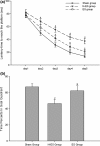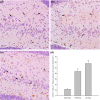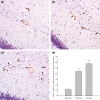Electrical stimulation improved cognitive deficits associated with traumatic brain injury in rats
- PMID: 29201537
- PMCID: PMC5698854
- DOI: 10.1002/brb3.667
Electrical stimulation improved cognitive deficits associated with traumatic brain injury in rats
Abstract
Introduction: Cognitive deficits associated with traumatic brain injury (TBI) reduce patient quality of life. However, to date, there have been no effective treatments for TBI-associated cognitive deficits. In this study, we aimed to determine whether electrical stimulation (ES) improves cognitive deficits in TBI rats.
Methods: Rats were randomly divided into three groups: the Sham control group, electrical stimulation group (ES group), and No electrical stimulation control group (N-ES group). Following fluid percussion injury, the rats in the ES group received ES treatment for 3 weeks. Potent cognitive function-relevant factors, including the escape latency, time percentage in the goal quadrant, and numbers of CD34+ cells, von Willebrand Factor+ (vWF +) vessels, and circulating endothelial progenitor cells (EPCs), were subsequently assessed using the Morris water maze (MWM) test, immunohistochemical staining, and flow cytometry.
Results: Compared with the rats in the N-ES group, the rats in the ES group exhibited a shorter escape latency on day 3 (p = .025), day 4 (p = .011), and day 5 (p = .003), as well as a higher time percentage in the goal quadrant (p = .025) in the MWM test. After 3 weeks of ES, there were increased numbers of CD34+ cells (p = .008) and vWF + vessels (p = .000) in the hippocampus of injured brain tissue in the ES group compared with those in the N-ES group. Moreover, ES also significantly increased the number of EPCs in the peripheral blood from days 3 to 21 after TBI in the ES group (p < .05).
Conclusions: Taken together, these findings suggest that ES may improve cognitive deficits induced by TBI, and this protective effect may be a result, in part, of enhanced angiogenesis, which may be attributed to the increased mobilization of EPCs in peripheral blood.
Keywords: angiogenesis; cognitive deficit; electrical stimulation; endothelial progenitor cell; traumatic brain injury.
Figures




Similar articles
-
Dexamethasone impairs neurofunctional recovery in rats following traumatic brain injury by reducing circulating endothelial progenitor cells and angiogenesis.Brain Res. 2019 Dec 15;1725:146469. doi: 10.1016/j.brainres.2019.146469. Epub 2019 Sep 18. Brain Res. 2019. PMID: 31541641
-
Improvement in cognitive dysfunction following blast induced traumatic brain injury by thymosin α1 in rats: Involvement of inhibition of tau phosphorylation at the Thr205 epitope.Brain Res. 2020 Nov 15;1747:147038. doi: 10.1016/j.brainres.2020.147038. Epub 2020 Jul 30. Brain Res. 2020. PMID: 32738231
-
Cortical Electrical Stimulation Ameliorates Traumatic Brain Injury-Induced Sensorimotor and Cognitive Deficits in Rats.Front Neural Circuits. 2021 Jun 14;15:693073. doi: 10.3389/fncir.2021.693073. eCollection 2021. Front Neural Circuits. 2021. PMID: 34194304 Free PMC article.
-
Changes in the components of visual attention following traumatic brain injury: A systematic review and meta-analysis.PLoS One. 2022 Jun 9;17(6):e0268951. doi: 10.1371/journal.pone.0268951. eCollection 2022. PLoS One. 2022. PMID: 35679230 Free PMC article.
-
Metabolic disorders on cognitive dysfunction after traumatic brain injury.Trends Endocrinol Metab. 2022 Jul;33(7):451-462. doi: 10.1016/j.tem.2022.04.003. Epub 2022 May 7. Trends Endocrinol Metab. 2022. PMID: 35534336 Review.
Cited by
-
Short-Term Cortical Electrical Stimulation during the Acute Stage of Traumatic Brain Injury Improves Functional Recovery.Biomedicines. 2022 Aug 12;10(8):1965. doi: 10.3390/biomedicines10081965. Biomedicines. 2022. PMID: 36009512 Free PMC article.
-
Novel Electrode Designs for Neurostimulation in Regenerative Medicine: Activation of Stem Cells.Bioelectricity. 2020 Dec 1;2(4):348-361. doi: 10.1089/bioe.2020.0034. Epub 2020 Dec 16. Bioelectricity. 2020. PMID: 34471854 Free PMC article. Review.
-
Excitation of the Pre-frontal and Primary Visual Cortex in Response to Transcorneal Electrical Stimulation in Retinal Degeneration Mice.Front Neurosci. 2020 Oct 9;14:572299. doi: 10.3389/fnins.2020.572299. eCollection 2020. Front Neurosci. 2020. PMID: 33162879 Free PMC article.
-
Activation of the primary motor cortex using fully-implanted electrical sciatic nerve stimulation.Exp Ther Med. 2019 Nov;18(5):3357-3364. doi: 10.3892/etm.2019.7993. Epub 2019 Sep 9. Exp Ther Med. 2019. PMID: 31602209 Free PMC article.
-
Towards Novel Geneless Approaches for Therapeutic Angiogenesis.Front Physiol. 2021 Jan 20;11:616189. doi: 10.3389/fphys.2020.616189. eCollection 2020. Front Physiol. 2021. PMID: 33551844 Free PMC article.
References
-
- Baba, T. , Kameda, M. , Yasuhara, T. , Morimoto, T. , Kondo, A. , Shingo, T. , … Borlongan, C. V. (2009). Electrical stimulation of the cerebral cortex exerts antiapoptotic, angiogenic, and anti‐inflammatory effects in ischemic stroke rats through phosphoinositide 3‐kinase/Akt signaling pathway. Stroke, 40, e598–e605. - PubMed
-
- Bohnen, N. l. , Jolles, J. , & Twijnstra, A. (1992). Neuropsychological deficits in patients with persistent symptoms six months after mild head injury. Neurosurgery, 30, 692–696. - PubMed
-
- Chen, X. , Zhang, K.‐L. , Yang, S.‐Y. , Dong, J.‐F. , & Zhang, J.‐N. (2009). Glucocorticoids aggravate retrograde memory deficiency associated with traumatic brain injury in rats. Journal of Neurotrauma, 26, 253–260. - PubMed
-
- Cheng, X. , Li, T. , Zhou, H. , Zhang, Q. , Tan, J. , Gao, W. , … Duan, Y. Y. (2012). Cortical electrical stimulation with varied low frequencies promotes functional recovery and brain remodeling in a rat model of ischemia. Brain Research Bulletin, 89, 124–132. - PubMed
MeSH terms
Substances
LinkOut - more resources
Full Text Sources
Other Literature Sources
Miscellaneous

